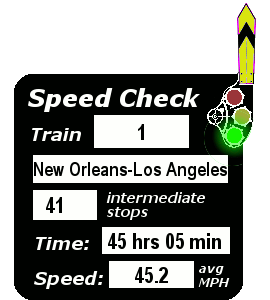NOTE:
"CALIFORNIA — State law provides for 'Daylight Saving' time throughout
the State annually commencing the last Sunday in April and ending the
last Sunday in September [1960]."
SUNSET
ROUTE
NEW ORLEANS - HOUSTON - SAN ANTONIO - EL
PASO - SOUTHERN ARIZONA - LOS ANGELES
EQUIPMENT
TRAINS 1-2—STREAMLINER SUNSET.
Extra Fare.
Full Lounge Car—
New
Orleans-Los Angeles. (For Pullman passengers.) (Shower bath and valet
service.)
Sleeping Cars—
New
Orleans-Los Angeles. (Roomettes, Bedrooms, Compartments, Drawing-rooms.)
Dallas-Los
Angeles. Westbound on T. & P. No. 1 to El Paso; Eastbound on T.
& P. No. 8 to Dallas. (Roomettes, Bedrooms.)
Chair Cars—
New
Orleans-Los Angeles.
El
Paso-Los Angeles.
Reclining
leg rest seats.
Pillow
service available at nominal charge.
Reserve
seats in advance.
Dining Car—
New
Orleans-Los Angeles.
Hamburger Grill Car—
El
Paso-Los Angeles. (For chair car passengers.)
News Agent Service.
Baggage—No
checked baggage service train No. 1 to or from Deming, Lordsburg,
Wilcox and Benson.
Most
convenient service to Imperial Valley points is available by detraining
at Yuma westbound or Los Angeles eastbound using Western Greyhound
Lines bus from Yuma or Los Angeles to destination. Rail tickets
optionally honored. Rail and Bus stations at Niland are located
approximately one-half mile apart and only infrequent bus service is
available from this point to Imperial Valley destinations.









Before the Fall
As with the Golden State and the Imperial, the Sunset Limited had always had a "running mate" to handle small-town and short-hop passengers, with a schedule that could be tweaked to provide service to major destinations during normal waking hours if the other passed through in the dead of night. In this case it was the Sunset Limited which had the fancy new equipment, the tight schedule, and the cachet, while the Argonaut was the workhorse which handled mail and express and the "whistle stop" travelers.By the late 1950s the highways and the airlines had siphoned off enough customers that passenger railroads were definitely bleeding red ink. Southern Pacific was especially feeling the pinch. In an earlier era Espee management had been willing to let freight profits subsidize passenger losses, but as the new Interstates tilted that playing field in favor of truck lines the freight profits were drying up as well. The passenger trains that couldn't pay their own way would have to go.
At first, it seems, Espee's plan was to eliminate the redundancies and excess capacity in its passenger timetables, but continue to operate the surviving trains to a high standard. So, between the two daily trains on the Sunset Route, it was the Argonaut which had to go. It would be truncated to a Houston-New Orleans train on June 7, 1958, and eventually discontinued altogether in 1963. The Sunset would inherit its mail and express business and lose its title as a "Limited". For the remainder of its days as a Southern Pacific train, it would be known simply as the "Sunset".